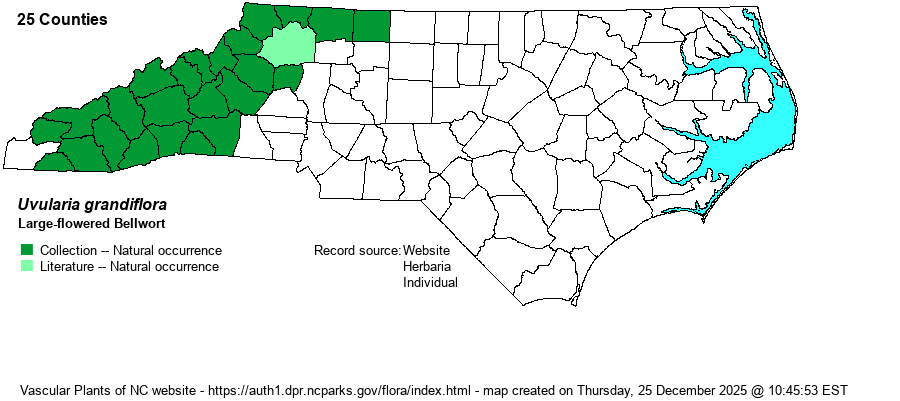| Author | J.E. Smith | |
| Distribution | Throughout the Mountains, and also present eastward into the western Piedmont foothills and monadnocks, east to Stokes County. SERNEC specimens from Guilford, Forsyth, Davidson, and Gaston counties are not included on the map for likelihood of misidentification.
This is a species of the eastern US and southern Canada, but with its abundance centered west of the Appalachians, where present in most counties in the Great Lakes states and others bordering the Mississippi River. The eastern edge of the range follows the Appalachians south to northern GA. | |
| Abundance | Fairly common to frequent in the Mountains, in a wide range of elevations. Rare to locally uncommon in the western Piedmont, essentially in the lower Mountains and outlier monadnocks. | |
| Habitat | This is a species of rich hardwood forests and is a characteristic species of the Rich Cove Forest natural community. It also can be found in Northern Hardwood Forests, but it is not widespread in Acidic Cove Forests. | |
| Phenology | Blooms from mid-April to mid-May, and fruits in July and August. It tends to flower slightly later than the more common and widespread U. perfoliata. | |
| Identification | This is a striking species when in full bloom, It grows to about 1.5-2 feet tall, and typically there are several branches off the stem. There are scattered entire and elliptical leaves along the stem and branches, and each leaf is perfoliate, such that the stem "pierces" the leaf; each leaf is about 3-4 inches long and typically droops downward. The many yellow flowers dangle downward (as do all of the bellworts), with the 6 tepals practically touching each other in a "closed" look. The flower is about 1-1.5 inches long and a bright golden-yellow, a deeper or richer color than the paler yellow of the similar U. perfoliata. This latter species has slightly smaller and paler flowers, the flowers are "pebbled"/rough on the inside, and the leaves are smooth and often a bit glaucous on the undersides. Both species can grow together on the same mountain slopes, and even when not in bloom they can be identified by experienced observers. Once in full bloom, there should be no identification issues by anyone, as U. grandiflora has bright golden-yellow flowers and is a more stately species. This is one of the many target wildflower species for those walking in rich cove forests in the spring season. | |
| Taxonomic Comments | None
| |
| Other Common Name(s) | Merrybells | |
| State Rank | S4 | |
| Global Rank | G5 | |
| State Status | | |
| US Status | | |
| USACE-agcp | | |
| USACE-emp | | |

